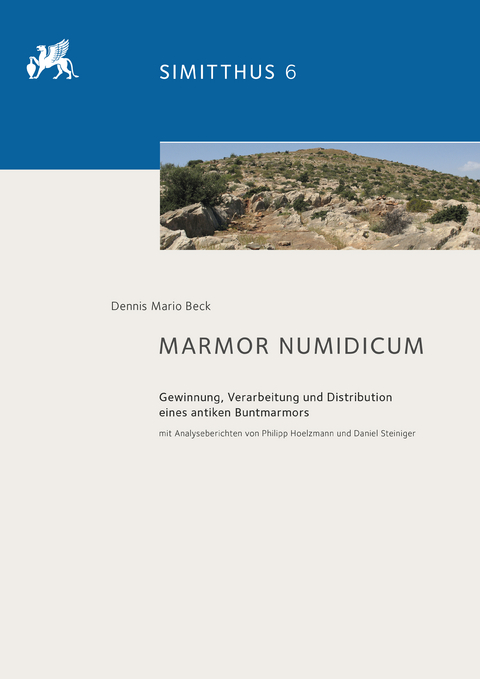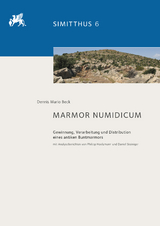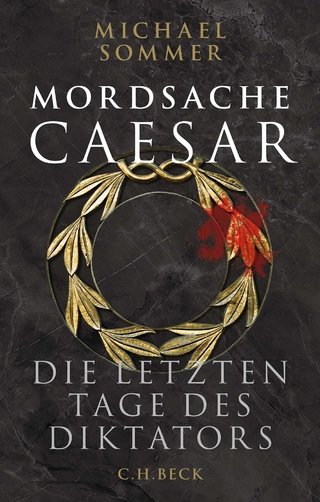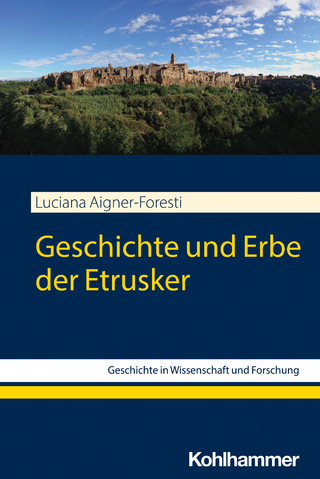Marmor Numidicum
Gewinnung, Verarbeitung und Distribution eines antiken Buntmarmors
Seiten
2024
Reichert, L (Verlag)
978-3-7520-0755-8 (ISBN)
Reichert, L (Verlag)
978-3-7520-0755-8 (ISBN)
Der marmor numidicum, auch als Giallo antico bekannt, ist einer der am weitesten verbreiteten Buntmarmore der Antike, der in Simitthus, dem heutigen Chimtou in Tunesien abgebaut wurde. Die Arbeit legt erstmals eine holistische Einzelstudie zum marmor numidicum durch die Zusammenführung der Ergebnisse aus verschiedenen Fachdisziplinen vor. Die Basis bildet eine Materialaufnahme zur Erfassung des Verwendungsspektrums und der Distribution dieses Marmors im Mittelmeerraum vom 2. Jh. v. Chr. bis ins 3. Jh. n. Chr., die als Grundlage für Auswertungen z. B. zum Marmorhandel, Transport und den beteiligten Akteuren fungiert.
marmor numidicum, also known as Giallo antico, is one of the best known and most widespread colored marbles of antiquity, and was quarried in Simitthus, today Chimtou in Tunisia. The present study is a holistic interdisciplinary approach to marmor numidicum and combines the results from different research disciplines. The basis is a collection of archaeological material for the recording of the spectrum of use and the distribution of the marble in the Mediterranean area from the 2nd century B.C. to the 3rd century A.D. Based on this dataset, conclusions are drawn in a diachronic perspective both on the marble extraction and chronology in the quarries and on the urban genesis as well as the use and distribution range of the marble. The results are correlated by means of comparisons with administrative structures and questions of ownership, too. The study presents a periodization and localization of all variants of the marble to their extraction areas, considering archaeometric analyses of samples from the quarries for the first time in research. Another aspect concerns the role of marmor numidicum within ancient trade systems. In order to get closer to these perspectives, questions about extraction, actors in trade networks, transport and logistic issues are comparatively analyzed with the help of the spectrum of use and distribution in diachronic evaluations and contextualized in case studies with the model of the chaîne opératoire. Theories and models from New Institutions Economics are discussed, too. Regarding the use of the local marble, the study yielded the result that the city of Simitthus and its quarries formed an entangled unit over the periods studied. Thus, for one of the most important colored marbles of antiquity a single study is now available. Der marmor numidicum, auch als Giallo antico bekannt, ist einer der bekanntesten und am weitesten verbreiteten Buntmarmore der Antike, der in Simitthus, dem heutigen Chimtou in Tunesien abgebaut wurde. Die Arbeit stellt eine holistisch angelegte interdisziplinäre Einzelstudie zum marmor numidicum dar. Die Grundlage bildet eine Materialaufnahme zur Erfassung des Verwendungsspektrums und der Distribution dieses Marmors im Mittelmeerraum vom 2. Jh. v. Chr. bis ins 3. Jh. n. Chr. Anhand dieser Materialsammlung werden in diachroner Perspektive jeweils sowohl Rückschlüsse auf die Marmorgewinnung und Chronologie in den Steinbrüchen als auch auf die Stadtgenese gezogen und diese über Vergleiche mit administrativen Strukturen und Besitzverhältnissen korreliert. Zudem wird die Verwendung und Distribution erfasst und in Kontexten aus dem Mittelmeerraum analysiert. Die Arbeit legt eine Periodisierung und Zuweisung aller Varianten des Marmors zu ihren Abbauarealen unter Berücksichtigung archäometrischer Analysen von Proben aus den Steinbrüchen vor. Ein weiterer Aspekt betrifft die Rolle des marmor numidicum innerhalb antiker Handelssysteme. Um diesen Perspektiven näher zu kommen, werden mithilfe des Einsatzspektrums und der Distribution in diachronen Auswertungen Fragen nach Abbauszenarien, Akteuren in Handelsnetzwerken, Transport- und Logistikfragen synoptisch analysiert und in Fallbeispielen mit dem Modell der chaîne opératoire kontextualisiert. Hierzu werden Theorien und Modelle aus der Neuen Institutionenökonomik miteinbezogen. In Bezug auf die lokale Verwendung des Marmors lieferte die Studie das Ergebnis, dass die Stadt Simitthus und ihre Steinbrüche über die untersuchten Zeiträume hinweg eine verflochtene Einheit bildeten. Damit liegt erstmals für einen der wichtigsten Buntmarmore der Antike eine Einzelstudie vor.
marmor numidicum, also known as Giallo antico, is one of the best known and most widespread colored marbles of antiquity, and was quarried in Simitthus, today Chimtou in Tunisia. The present study is a holistic interdisciplinary approach to marmor numidicum and combines the results from different research disciplines. The basis is a collection of archaeological material for the recording of the spectrum of use and the distribution of the marble in the Mediterranean area from the 2nd century B.C. to the 3rd century A.D. Based on this dataset, conclusions are drawn in a diachronic perspective both on the marble extraction and chronology in the quarries and on the urban genesis as well as the use and distribution range of the marble. The results are correlated by means of comparisons with administrative structures and questions of ownership, too. The study presents a periodization and localization of all variants of the marble to their extraction areas, considering archaeometric analyses of samples from the quarries for the first time in research. Another aspect concerns the role of marmor numidicum within ancient trade systems. In order to get closer to these perspectives, questions about extraction, actors in trade networks, transport and logistic issues are comparatively analyzed with the help of the spectrum of use and distribution in diachronic evaluations and contextualized in case studies with the model of the chaîne opératoire. Theories and models from New Institutions Economics are discussed, too. Regarding the use of the local marble, the study yielded the result that the city of Simitthus and its quarries formed an entangled unit over the periods studied. Thus, for one of the most important colored marbles of antiquity a single study is now available. Der marmor numidicum, auch als Giallo antico bekannt, ist einer der bekanntesten und am weitesten verbreiteten Buntmarmore der Antike, der in Simitthus, dem heutigen Chimtou in Tunesien abgebaut wurde. Die Arbeit stellt eine holistisch angelegte interdisziplinäre Einzelstudie zum marmor numidicum dar. Die Grundlage bildet eine Materialaufnahme zur Erfassung des Verwendungsspektrums und der Distribution dieses Marmors im Mittelmeerraum vom 2. Jh. v. Chr. bis ins 3. Jh. n. Chr. Anhand dieser Materialsammlung werden in diachroner Perspektive jeweils sowohl Rückschlüsse auf die Marmorgewinnung und Chronologie in den Steinbrüchen als auch auf die Stadtgenese gezogen und diese über Vergleiche mit administrativen Strukturen und Besitzverhältnissen korreliert. Zudem wird die Verwendung und Distribution erfasst und in Kontexten aus dem Mittelmeerraum analysiert. Die Arbeit legt eine Periodisierung und Zuweisung aller Varianten des Marmors zu ihren Abbauarealen unter Berücksichtigung archäometrischer Analysen von Proben aus den Steinbrüchen vor. Ein weiterer Aspekt betrifft die Rolle des marmor numidicum innerhalb antiker Handelssysteme. Um diesen Perspektiven näher zu kommen, werden mithilfe des Einsatzspektrums und der Distribution in diachronen Auswertungen Fragen nach Abbauszenarien, Akteuren in Handelsnetzwerken, Transport- und Logistikfragen synoptisch analysiert und in Fallbeispielen mit dem Modell der chaîne opératoire kontextualisiert. Hierzu werden Theorien und Modelle aus der Neuen Institutionenökonomik miteinbezogen. In Bezug auf die lokale Verwendung des Marmors lieferte die Studie das Ergebnis, dass die Stadt Simitthus und ihre Steinbrüche über die untersuchten Zeiträume hinweg eine verflochtene Einheit bildeten. Damit liegt erstmals für einen der wichtigsten Buntmarmore der Antike eine Einzelstudie vor.
| Erscheinungsdatum | 05.06.2024 |
|---|---|
| Reihe/Serie | Simitthus |
| Zusatzinfo | 18 Tafeln |
| Verlagsort | Wiesbaden |
| Sprache | deutsch |
| Maße | 210 x 297 mm |
| Gewicht | 2150 g |
| Themenwelt | Geisteswissenschaften ► Archäologie |
| Geschichte ► Allgemeine Geschichte ► Altertum / Antike | |
| Schlagworte | Altertumswissenschaften • Archäologie • Bauforschung • Infrastruktur • Mamor • Simitthus • Spätantike • Tunesien • Verarbeitung |
| ISBN-10 | 3-7520-0755-9 / 3752007559 |
| ISBN-13 | 978-3-7520-0755-8 / 9783752007558 |
| Zustand | Neuware |
| Informationen gemäß Produktsicherheitsverordnung (GPSR) | |
| Haben Sie eine Frage zum Produkt? |
Mehr entdecken
aus dem Bereich
aus dem Bereich




